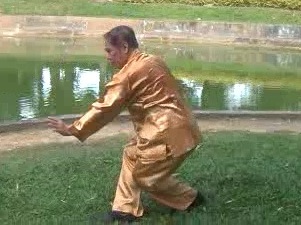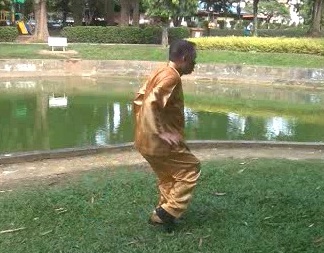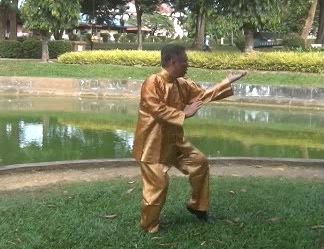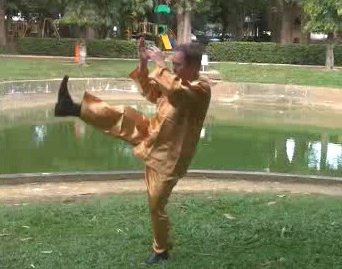THE 12 ANIMALS OF XINGYIQUAN

Dragon
Question 8a
In Xing Yi Quan, there are 12 animals. Among them are the Dragon, Tiger and Snake, 3 of the 5 important animals in Southern Shaolin Kung Fu. Is there any difference in the external forms, the internal aspects and the applications of these animals in Xing Yi Quan when compared to Southern Shaolin?
Sifu Roeland Dijkema
Question 8b
What is the source of the twelve animals present in Xing Yi Chuan? As it was developed from Shaolin, is it safe to assume these animal forms had already formulated in one way or another? If not, how do you suppose that the founder of Xing Yi Chuan became inspired by these animals? And we know that history tells us that Xing Yi Chuan evolved out of Shaolin martial arts. But is there any record of what specific Shaolin sets Yue Fei was trained in or was known for?
Sunwukong
Answer
The 12 animal-forms of Xingyiquan are quite different from the 5 animal-forms of Southern Shaolin, like Hoong Ka and Choy Li-Fatt.
The Xingyiquan 12 animal-forms came first, the Southern Shaolin five animal-forms came later, with about 600 years in between. It is therefore incorrect to say that the Xingyiquan animal-forms were derived from the famous Shaolin “five animals”, as many people mistakenly think.
I have not seen any Five-Animal Set of Northern Shaolin, but I have some classics showing the five animals of Shaolin Kungfu in the Ming Dynasty (14th to 17th century). As both Northern Shaolin and Southern Shaolin were in existence during the Ming Dynasty, I am not sure whether the five animals refer to Northern Shaolin or Southern Shaolin. The pictures look Southern, but the descriptions of skills point to Northern.
I would guess that as this was the transitional period, the kungfu practiced at the northern Shaolin Monastery in Hunan and at the southern Shaolin Monastery in Fujian was quite similar. It was later that the difference became accentuated.
What is interesting about the pictures of the Shaolin five animals shown in the Ming classics is that they do not look like any of the Southern Shaolin 5 animal-forms. Although the pictures in the classics are named as dragon, snake, tiger, leopard and crane, they do not resemble anything like dragon, snake, tiger, leopard and crane.
All the pictures look alike. If I were to pick one of the five Shaolin animals, I would say all the pictures look like a tiger-form, mainly because the hands are held like claws. I had the classics long ago, at a time when my knowledge of kungfu philosophy was superficial. It was much later that I realized it is not the outward form (that can be shown in pictures) but the spirit of the form (that cannot be shown in pictures) that is important.
The classic clearly explains the spirit involved in the training. The dragon is to train mind, the snake to train energy, the tiger to train internal force, the leopard to train speed, and the crane to train essence.
What Yue Fei (12th century) learned was Northern Shaolin Kungfu, at a time when the southern Shaolin Monastery was not yet built. Both the spirit and the form of Xingyiquan 12 animals are different from those of Southern Shaolin 5 animals, though there are similarities with animals of various Shaolin styles due to overlapping.
The 12 animal-forms are shown in Twelve Animal-Forms of Xingyiquan. The spirit of the forms is found in a “song of 12 animal-forms” found in a classic, and reproduced at the webpage above.

Tiger
I shall summarize the spirit of the Xingyiquan 12-animal forms as follows:
Dragon -- contracting and expanding
Tiger -- courage
Monkey -- agility
Horse -- speed
Alligator -- gliding
Cockerel -- combative
Hawk -- soaring
Swallow -- skimming
Snake -- sliding
Ostrich -- ramming
Eagle -- gripping
Bear -- stability
The agility as well as the outward form of the monkey are found in all Shaolin styles. The form of the horse and also the snake is similar in Xingyiquan and in Southern Shaolin. Both the spirit and the form of the sparrow are the same in these two Shaolin styles. The form and the spirit of the eagle are the same in Xingyiquan and Eagle Claw Kungfu. The form and the spirit of the bear are similar in Xingyiquan and in Taijiquan.
On the other hand, the difference in both the form and the internal aspects of some animal-forms in Xingyiquan and Southern Shaolin are striking.
Xingyiquan dragon uses the Dragon-Embracing Stance and its spirit is contracting and expanding. Southern Shaolin dragon uses the Horse-Riding Stance or the Bow-Arrow Stance, is often swerving and its internal aspect is to train mind.
Although both Xingyiquan tiger and Southern Shaolin tiger use claws, the way the claws are formed is different. What is tiger-claw in Xingyiquan is eagle-claw in Eagle Claw Kungfu and Southern Shaolin. As both Xingyiquan and Eagle Claw Kungfu were invented by him and the claws in both arts are similar, apparently Yue Fei was not particular about names.
The alligator is common in Xingyiquan but not found in Southern Shaolin.
The cockerel is very important in Xingyiquan, but in Southern Shaolin it is incorporated into the crane. "Golden Cockerel Stands Solitarily" in Southern Shaolin is sometimes called "White Crane Flaps Wings". Xingyiquan cockerel finds its way into Taijiquan, but the spirit is quite different. In Xingyiquan the cockerel is aggressive, but in Taijiquan, as in "Golden Cockerel Stands Solitarily", the form is different from that in Southern Shaolin, and it is unobtrusive.
The ostrich is probably found only in Xingyiquan and not in any other kungfu styles. Some Xingyiquan masters question whether the term "ostrich" was actually used, arguing that the ostrich was not native to China. Personally I do not find this argument valid. The lion is not native to China, but its term is used in many kungfu styles.
There were no records of where Yue Fei derived the 12 animal-forms from. Probably many of the animal-forms were derived from the Shaolin Kungfu he had learned from his master, Zhou Tong, and some Yue Fei invented on his own to meet expedient needs.
Yue Fei was a kungfu genius. He was deified as the god of martial arts. Three kungfu styles -- Xingyiquan, Eagle Claw Kungfu and Yue Family Kungfu -- are all attributed to him. All these styles are quite different in their nature, philosophy and application, and they are all very effective.

Monkey
It is interesting to note that Yue Fei's teacher, Zhou Tong, was the second generation successor of Chuo Jiao Kungfu, a little known kungfu famous for kicks, invented by Deng Liang. Yue Fei was the third generation successor. But these Chuo Jiao kicks, which would render Taekwondo kicks and Muay Thai kicks rudimentary, are not found in Xingyiquan, Eagle Claw and Yue Family Kungfu.
On the other hand, the difference in both the form and the internal aspects of some animal-forms in Xingyiquan and Southern Shaolin are striking.
Xingyiquan dragon uses the Dragon-Embracing Stance and its spirit is contracting and expanding. Southern Shaolin dragon uses the Horse-Riding Stance or the Bow-Arrow Stance, is often swerving and its internal aspect is to train mind.
Although both Xingyiquan tiger and Southern Shaolin tiger use claws, the way the claws are formed is different. What is tiger-claw in Xingyiquan is eagle-claw in Eagle Claw Kungfu and Southern Shaolin. As both Xingyiquan and Eagle Claw Kungfu were invented by him and the claws in both arts are similar, apparently Yue Fei was not particular about names.
It was unlikely that Yue Fei sat in his tent with a cup of wine in his hand, thinking of animal-forms like dragons and alligators, and how to compose them into Xingyiquan. This would be the work of a dreamer, not a marshal at the frontline of battles. It was more likely that Yue Fei, finding his generals lacking in some combat techniques and skills, drew from his rich kungfu repertoire techniques and skills to teach the generals to meet their immediate needs.
At first Yue Fei taught the generals only the five elemental fists. It was later, finding that the five elemental fists were not enough in certain combat situations, that he taught them the 12 animal-forms as a supplement.
We go through the same process in our school. Our 16 basic Shaolin combat sequences, for example, were not invented by me sitting comfortably on a sofa with a can of coca cola in my hand, thinking of how to compose fanciful patterns into a course to teach students. It was finding students struggling to use kungfu patterns in free sparring that I drew from my rich repertoire kungfu skills and techniques to teach them so that they could be competent using kungfu in combat. Later when I found that the kungfu techniques are insufficient to meet simple, fast Boxers' jabs, grapplers' take-downs and attacks from other martial arts, I taught more simple counters against these other arts as a supplement.
The coming Xingyiquan course is also taught to meet immediate needs -- the needs to expand kungfu understanding beyond our core Shaolin and Taijiquan syllabuses, to experience and benefit from great styles of great masters.
It was also unlikely that Yue Fei first thought about terms like dragons, hawks and alligators. It was more likely that later masters provided these names as well as the philosophy to explain effective training and application for convenience and better understanding.
As far as I know there were no direct statements on what exact Shaolin sets or arts Yue Fei was trained in and what he used to invent Xingyiquan. But indirect evidence from the classics as well as other literature indicates that he was trained in Northern Lohan Kungfu, Taizu Changquan (Long Fist of First Emperor, i.e. Zhao Kuang Yin, the first emperor of the Song Dynasty who was a Shaolin disciple) and Chuo Jiao Kungfu.
The forms in Xingyiquan resemble those in Lohan Kungfu and Taizu Kungfu. But Chuo Jiao kicks are noticeably absent.
Throughout kungfu history, Yue Fei was most famous for Xingyiquan, then for Eagle Claw Kungfu, the two arts that he invented and trained in after the invention. He was not so widely known as the inventor of Yue Family Kungfu, though all its practitioners as well as informed persons credited its invention to Yue Fei.

Swallow
Xingyiquan Questions and Answers
The questions and answers are reproduced from the thread 10 Questions to Sifu about Xingyiquan in the Shaolin Wahnam Discussion Forum.
LINKS
